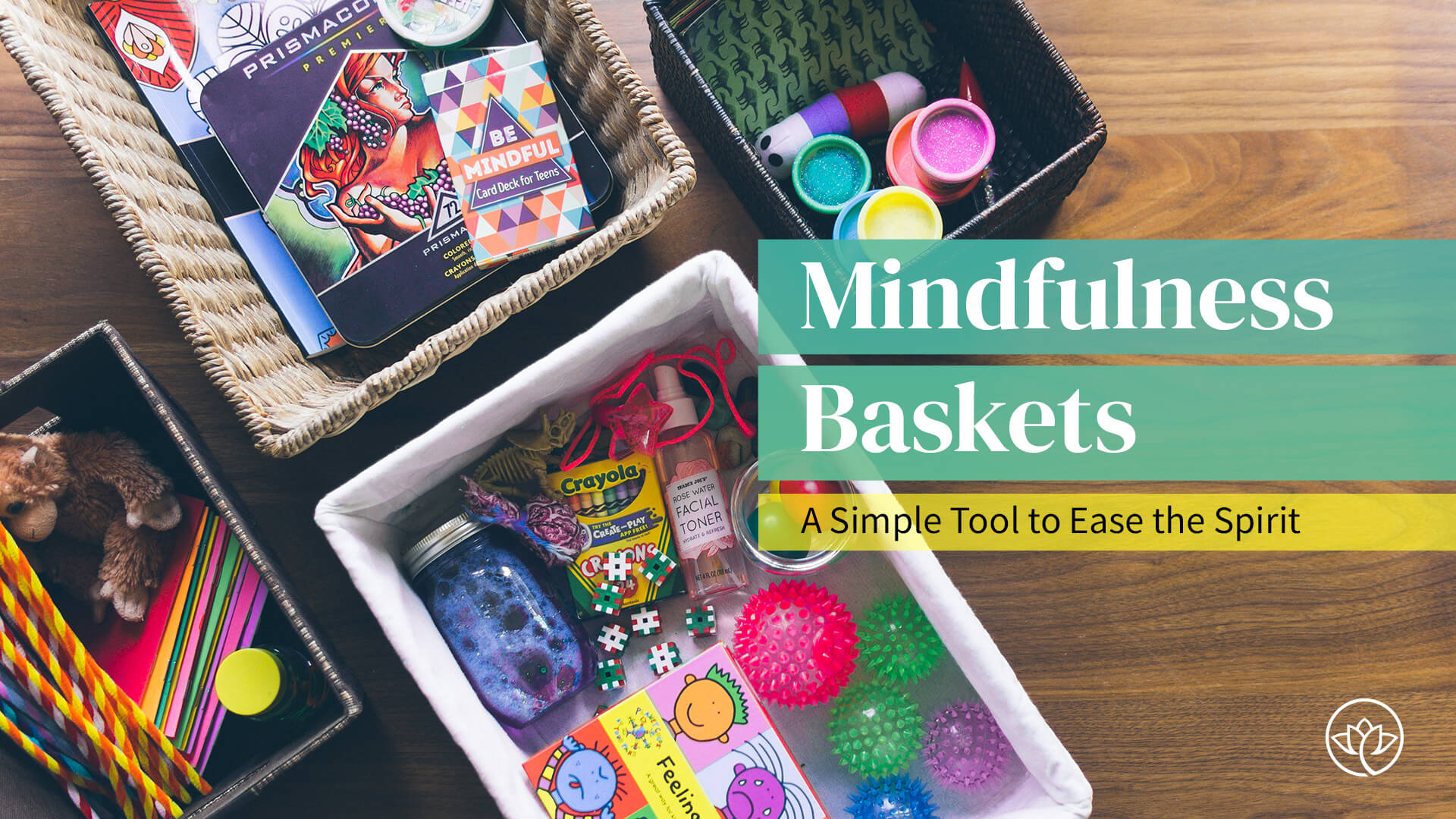
What is a Mindfulness Basket?
Mindfulness, Calming, or Calm Down Baskets are boxes, containers, or baskets that hold various items that are used for calming and regulating. The basket is a tool that helps with grounding and relaxation, so it can be used as a regular mindfulness practice. It’s also particularly helpful with soothing upset feelings.
How to Use it
If your child is feeling sad, disconnected, frustrated, or otherwise dysregulated, first offer your presence and connection. When she begins to settle, invite her to explore the contents of the Mindfulness Basket with you to see if there’s something that draws her attention.
If your child is too upset to connect with any of the items in the basket, continue to stay close, offering soothing words of empathy and reassurance. When he’s ready, invite him to choose something from the basket that appeals to him.
Creating a Cozy Space
It’s helpful to have a cozy space set up in your child’s bedroom or the living room where the basket can stay. We have a corner set up in our living room with plush beanbags and our Mindfulness Basket.
When I first set up our “Calming Corner,” I invited my kids to use it if they wanted to relax or enjoy some of the activities in the basket. This created a positive association with the space. Eventually, if either of them was feeling stressed, I invited them to sit with me on the beanbags and choose something from the basket to hold onto while we took a few breaths together. Over time, they learned to make use of this space on their own, and I sometimes find them there, taking a break from the day to connect with their thoughts and feelings.

What to Include in a Mindfulness Basket
Your mindfulness basket will be unique to your child, including those things that are most comforting to them, such as a favorite stuffed animal or book. I also recommend including some sensory tools, like a sachet of lavender (or other scent that is calming to your child); something smooth that they can touch, such as a polished stone; something that they can hear—a rainstick or shakers; something that they can look at, perhaps some photos of loved ones or other calming images; and something that they can taste, such as a favorite snack and a bottle of water.
I also include a few bottles of bubbles in our basket. This encourages some full inhales and slow, steady exhales, which is very soothing to the nervous system. If you’d rather not have bubbles indoors, stepping outside adds another element of calming—being able to see the sky and some green grass or leaves.
Adapting for Different Ages
This basket can be modified for different ages. For younger kids, I include Todd Parr’s Feelings Flashcards to help identify emotions, stuffed animals, a soft weighted blanket, animal or dinosaur figures, cars or trucks that can be rolled around, playdoh, and other sensory tools.
For older kids, I add a small box of Legos, a few chapter books, a coloring book with colored pencils, a card deck of affirmations, and some puzzles.
For teens and tweens, you could include an art journal and watercolors, origami paper, and a mindfulness tool such as the Be Mindful Card Deck for Teens.
Time to Reflect
There’s something very comforting about having a basket that’s available for anyone, anytime to help them to slow down, connect with their feelings, and move into a calmer, more expansive space. You might even find yourself enjoying the basket from time to time. I know I do!
List of Things to Include in Your Mindfulness Basket
Younger Kids
- Feelings Flashcards (to identify feelings and increase emotional literacy)
- Photos of loved ones or calming scenes
- Blank books (can be used to draw, write down feelings, or make empathy books)
- Kid’s rainstick
- Egg-style or other shakers
- Spiky Balls (to relieve stress)
- Stuffed animals
- Snacks with different textures such as pretzels or dried fruit
- Water bottle
- Glitter jars or glitter wands
- Newspaper or tissue paper to shred (Tearing paper is a safe way to express frustration.)
- Soft, weighted blanket like this one (The weight simulates the feeling of being held or hugged, which is calming to the nervous system.)
- A weighted stuffed animal (I use the Manimo Frog.)
- Classic Play-Doh or other kid-safe modeling compound
- Pinwheels or bubbles (to encourage full breaths and slow exhales)
- Pipe cleaners (for bending, twisting, and shaping)
- Coloring books and crayons
- Cars, trucks, vehicles
- Dinosaurs or other animal figures
Older Kids
Anything from the above list, plus:
- Lavender or other calming scents
- Mints
- Smooth, polished stones (for holding and calming)
- Feelings flashcards like the Todd Parr cards above or these for older kids
- Legos / Manipulatives
- Favorite chapter books or graphic novels
- Mandala or other mindfulness coloring book
- Colored pencils
- Affirmation cards
- Puzzles
- Rubik’s Cube (or other puzzles)
Teens and Tweens
Anything from the above lists, plus:
- Rose water mist (I like Trader Joe’s)
- Hand cream
- Essential oils with calming scents
- Art journal (Our favorite is this Canson mixed media pad.)
- Watercolor paint set (We love this Pelikan set.)
- Mindfulness coloring books like this one geared toward teens
- Origami Paper
- Be Mindful Card Deck for Teens
- Yarn for knitting or crocheting
As an Amazon Associate, I may earn a small commission from qualifying purchases on Amazon.com. Earnings Disclaimer.
